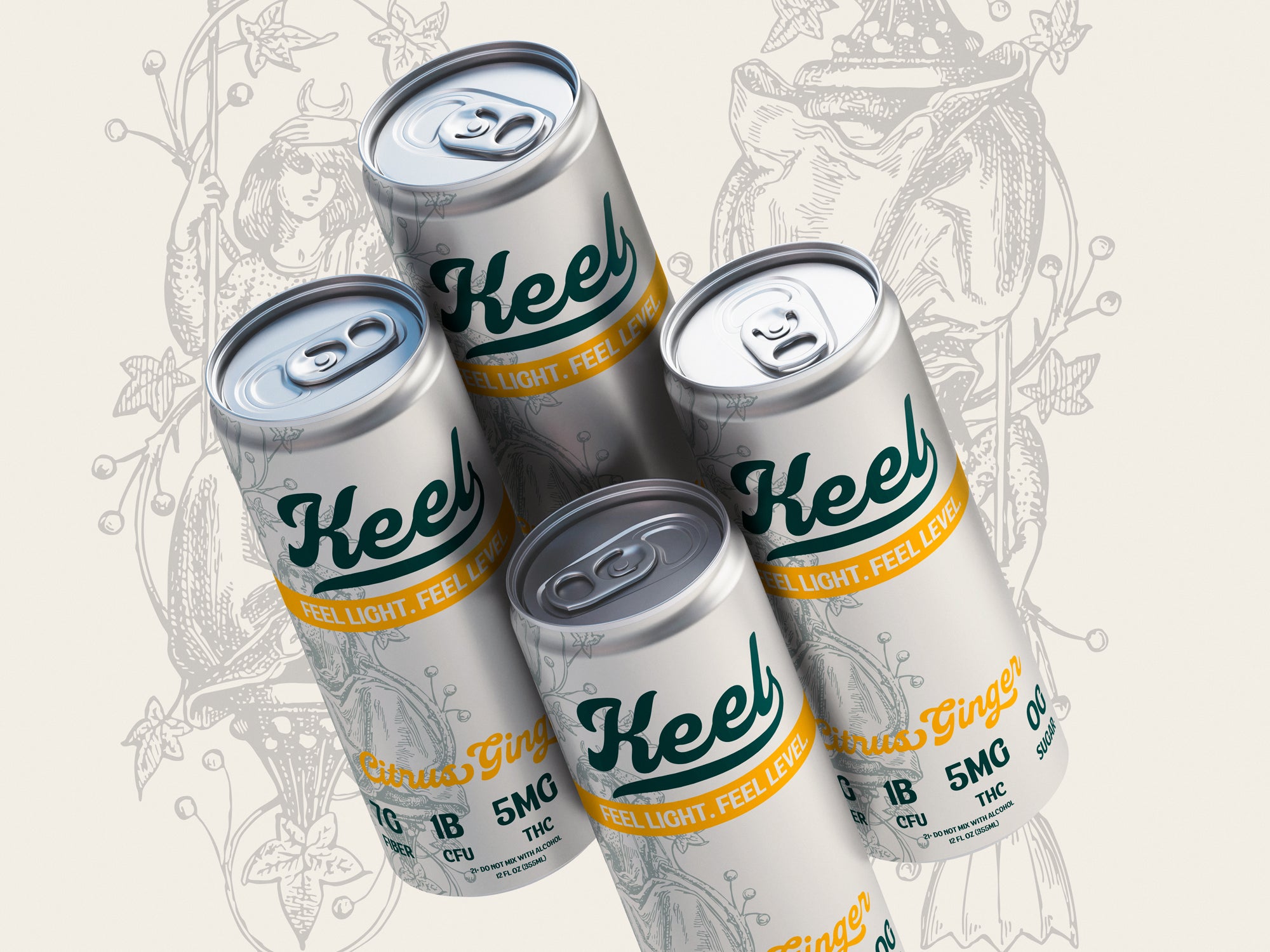TL;DR
PHGG (partially hydrolyzed guar gum) is a low-viscosity, soluble fiber that supports regularity without the thick, gel-like texture of psyllium or inulin. It dissolves clear in drinks, doesn't cause bloating for most people, and feeds beneficial gut bacteria to produce SCFAs. Effective dose: 5–7g daily. Look for drinks with PHGG listed by name (not just "dietary fiber"), under 5g added sugar, and paired with probiotics for synbiotic benefits.
PHGG (partially hydrolyzed guar gum) is a soluble, prebiotic fiber derived from guar beans and enzymatically broken down into smaller molecules, reducing its viscosity while preserving its gut health benefits. Unlike gel-forming fibers (psyllium, inulin, wheat dextrin), PHGG dissolves clear in liquids and produces a light, smooth mouthfeel, making it ideal for daily beverages. PHGG ferments slowly in the colon, feeding beneficial bacteria (Bifidobacteria, Lactobacilli) to produce short-chain fatty acids (SCFAs) that reduce inflammation and support regularity. Clinical studies show 5–7 grams of PHGG daily improves stool consistency, reduces constipation, and causes less bloating than high-viscosity fibers. Look for drinks that list PHGG by name, deliver 5+ grams per serving, and contain minimal added sugar.
What Is PHGG
PHGG stands for partially hydrolyzed guar gum. It's made from guar beans (Cyamopsis tetragonoloba), a legume grown primarily in India and Pakistan. The process begins with guar gum—a natural thickener extracted from guar bean seeds—which is then enzymatically hydrolyzed (broken down) into smaller polysaccharide chains. This hydrolysis reduces the fiber's molecular weight by 80–90%, lowering its viscosity (thickness) while maintaining its soluble fiber properties.
The result is a fiber that behaves differently from intact guar gum. Regular guar gum is highly viscous—it forms thick gels in water, which is why it's used in ice cream, sauces, and gluten-free baking. PHGG, by contrast, dissolves clear in cold or warm liquids with minimal thickening. A drink containing 7 grams of PHGG has the texture of slightly mineral-rich water, not the syrupy or chalky consistency of psyllium husk or inulin-heavy beverages.
PHGG is a prebiotic fiber, meaning it passes undigested through your stomach and small intestine, reaching your colon intact. There, gut bacteria ferment it into SCFAs (short-chain fatty acids): butyrate, propionate, and acetate. These SCFAs lower colon pH (inhibiting harmful bacteria), strengthen the intestinal barrier, and reduce systemic inflammation. A 2019 study in Nutrients found that 7 grams of PHGG daily for 4 weeks increased fecal butyrate levels by 35% and improved bowel movement frequency in participants with chronic constipation.
PHGG is also well-tolerated compared to other fibers. Its slow fermentation rate minimizes gas production, making it suitable for people with IBS or sensitive digestion. Unlike rapidly fermenting fibers (inulin, FOS), which can cause bloating and cramping, PHGG produces gas gradually over 12–24 hours, allowing your gut to adapt without discomfort.
PHGG vs Gel-Forming Fibers: Mouthfeel & Routine
The main difference between PHGG and gel-forming fibers (psyllium, inulin, wheat dextrin) is viscosity—how thick or gel-like the fiber becomes when mixed with liquid. This affects mouthfeel, digestibility, and how easily you can incorporate the fiber into your daily routine.
Mouthfeel: PHGG dissolves clear and remains low-viscosity, even at high doses. A drink with 7 grams of PHGG feels light and smooth, with no grittiness or sliminess. Psyllium, by contrast, swells into a gel within minutes of mixing, creating a thick, slightly gritty texture (think Metamucil). Inulin (from chicory root) can leave a chalky or syrupy aftertaste at high doses. Wheat dextrin (like Benefiber) is closer to PHGG in viscosity but doesn't ferment as effectively. PHGG's light texture makes it drinkable throughout the day without the "chore" feeling of downing a thick fiber shake.
Digestive tolerance: Gel-forming fibers absorb water in your stomach and intestines, which can cause fullness, bloating, or gas if you don't drink enough water. Psyllium requires 8+ ounces of water per dose to prevent constipation or intestinal blockage. PHGG, because it doesn't gel in your stomach, moves through your upper GI tract quickly and only ferments once it reaches the colon. This reduces bloating and makes PHGG suitable for people who react poorly to psyllium or inulin.
Routine integration: PHGG's low viscosity allows it to be mixed into any beverage (water, juice, coffee, smoothies) without altering texture. You can drink it cold or warm, carry it in a bottle all day, and sip it slowly without the fiber settling into a gel at the bottom. Psyllium must be consumed immediately after mixing—waiting 5 minutes turns it into a pudding-like mass that's difficult to swallow. This makes PHGG more convenient for daily use, especially for people who want fiber in a functional beverage rather than a dedicated fiber supplement.
Regularity timing: Both PHGG and psyllium support bowel regularity, but they work on different timelines. Psyllium adds bulk to stool immediately (within 12–24 hours) by absorbing water. PHGG softens stool and stimulates peristalsis (intestinal muscle contractions) over 24–48 hours through SCFA production. PHGG is better for long-term gut health (microbiome support, inflammation reduction), while psyllium is faster-acting for acute constipation relief.
PHGG vs Psyllium: Quick Comparison
| Factor | PHGG | Psyllium Husk |
|---|---|---|
| Viscosity | Low—dissolves clear, stays liquid | High—forms thick gel in 2–5 minutes |
| Mouthfeel | Light, smooth, no grittiness | Thick, slightly gritty or slimy |
| Bloating risk | Low—slow fermentation, minimal gas | Moderate—can cause bloating if underdosed on water |
| Water requirement | Optional (enhances comfort but not required) | Mandatory—8+ oz per dose to prevent blockage |
| Speed of action | 24–48 hours (gradual regularity via SCFAs) | 12–24 hours (immediate bulk to stool) |
| Prebiotic effect | Strong—feeds Bifidobacteria, Lactobacilli | Weak—mostly passes through unfermented |
| Best for | Daily gut health, IBS, long-term use in drinks | Acute constipation, fiber supplementation (powder) |
| Typical dose | 5–7 grams daily | 5–10 grams per dose, 1–3× daily |
How to Incorporate PHGG
PHGG's low viscosity and neutral taste make it easy to add to foods and beverages without altering flavor or texture. Here are practical ways to reach the effective 5–7 gram daily dose.
Beverages (easiest method): Look for functional drinks that list PHGG in the ingredients. A ready-to-drink beverage with 7 grams of PHGG delivers your full daily dose in one serving. PHGG pairs well with probiotics (creating a synbiotic effect) and dissolves in still or lightly carbonated drinks. You can also buy PHGG powder (brands like Sunfiber, Benefiber Prebiotic) and mix 1–2 tablespoons (5–7 grams) into water, juice, coffee, or tea. Stir for 10 seconds—it dissolves instantly with no clumping.
Smoothies and protein shakes: Add 1 tablespoon (5 grams) PHGG powder to your morning smoothie or post-workout shake. PHGG blends seamlessly and doesn't thicken the drink like chia seeds or flaxseed. It won't interfere with protein absorption and may enhance nutrient uptake by supporting gut barrier integrity.
Yogurt, oatmeal, and soups: Stir PHGG powder into yogurt, overnight oats, or warm soups. It dissolves without changing texture or taste. This method works well if you prefer spreading fiber intake across multiple meals rather than consuming it all at once. Start with 2–3 grams per meal (roughly 1 teaspoon) and increase to 5–7 grams total daily.
Baking and cooking: PHGG powder can be added to muffin batter, pancake mix, or sauces in small amounts (1–2 teaspoons per serving). Unlike regular guar gum, PHGG won't over-thicken baked goods. It remains stable at high temperatures, so cooking doesn't destroy its prebiotic properties.
Timing tips: Take PHGG with or without food—it works either way. For regularity, drink it in the morning to stimulate bowel movements 12–24 hours later. For microbiome support, spread doses throughout the day (3 grams morning, 3 grams evening). Pair with adequate water (6–8 glasses daily) to maximize comfort and prevent mild constipation in the adjustment period (first 3–5 days).
Label Reading Tips: Grams of Fiber, Sugar, Calories
When choosing a PHGG-containing product, check three label elements: fiber content, added sugar, and calorie count.
Fiber grams (look for 5–7 per serving): The ingredient list should specifically name "PHGG," "partially hydrolyzed guar gum," or "Sunfiber" (a trademarked PHGG brand). Vague terms like "dietary fiber" or "soluble fiber" don't confirm the fiber type. Clinical studies use 5–7 grams daily, so look for products delivering at least 5 grams per serving. Some drinks split the fiber across multiple servings—check serving size carefully. A can labeled "14 grams fiber" with 2 servings per can only gives you 7 grams per drink, which is still effective.
Added sugar (aim for under 5 grams): PHGG itself is tasteless and sugar-free, but flavored drinks often add sweeteners. High sugar content (10+ grams per serving) offsets fiber benefits by feeding harmful gut bacteria and spiking blood glucose. Choose drinks with 0–5 grams of added sugar. Natural sugars from fruit juice or listed as "from fiber" (PHGG contains trace oligosaccharides counted as sugar on labels) are fine. Avoid drinks sweetened primarily with cane sugar, high-fructose corn syrup, or agave nectar.
Calories (50 or fewer is ideal): PHGG contains about 2 calories per gram because it's partially fermented into SCFAs, which provide some energy. A drink with 7 grams of PHGG will have roughly 14 calories from fiber alone. If total calories exceed 50–75 per serving, the extra calories likely come from added sugar, juice, or other ingredients. Low-calorie PHGG drinks (under 50 calories) fit easily into most diets without impacting weight management goals.
Bonus checks: Look for products that pair PHGG with probiotics (creating a synbiotic). The prebiotic fiber feeds the probiotic bacteria, improving their survival and colonization. Also check for third-party testing—brands that publish COAs or have NSF/Informed Choice certification verify that the fiber content on the label matches what's in the product.
Frequently Asked Questions
Is PHGG bloat-friendly?
Yes, PHGG is one of the most bloat-friendly fibers available. Its slow fermentation rate in the colon produces gas gradually over 12–24 hours, giving your gut time to adapt without sudden distension. A 2017 study in Journal of Clinical Gastroenterology found that PHGG caused significantly less bloating and flatulence than inulin or FOS (fructooligosaccharides) in IBS patients. However, everyone's gut microbiome is different—start with 3–5 grams daily for the first week and increase to 7 grams once your body adjusts. Pair with water and avoid combining PHGG with other high-FODMAP foods (onions, garlic, beans) during the adjustment period if you're sensitive.
How much PHGG can I take daily?
The effective dose for digestive health is 5–7 grams per day. Clinical trials use doses ranging from 5–21 grams daily, with no serious adverse effects reported. Most people do well with 5–10 grams. Taking more than 15 grams daily may cause mild gas or loose stools as your gut bacteria ramp up fermentation. If you're new to fiber, start with 3–5 grams for one week, then increase to 7 grams. Upper tolerance is around 20–25 grams daily, but there's no benefit to exceeding 10 grams unless advised by a healthcare provider for specific conditions (severe constipation, IBS-C). Spread doses throughout the day if taking over 10 grams.
Can I take PHGG if I have IBS?
Yes. PHGG is well-studied for IBS, particularly IBS-C (constipation-predominant) and IBS-M (mixed type). A 2020 meta-analysis in Alimentary Pharmacology & Therapeutics found that PHGG improved overall IBS symptoms, stool consistency, and abdominal pain in 60% of participants over 8 weeks. PHGG is low-FODMAP, meaning it doesn't trigger fermentation-related symptoms in most IBS patients. Unlike high-FODMAP fibers (inulin, FOS, wheat dextrin), PHGG ferments slowly and selectively, avoiding the rapid gas production that worsens IBS symptoms. Start with 5 grams daily and monitor your response. If bloating occurs, reduce to 3 grams and increase gradually over 2–3 weeks.
Does PHGG need to be taken with food?
No. PHGG works with or without food. Taking it on an empty stomach moves it through your stomach faster, reaching the colon sooner to feed gut bacteria. Taking it with food slows digestion slightly but doesn't reduce effectiveness. Many people prefer drinking PHGG beverages first thing in the morning (on an empty stomach) to stimulate bowel movements later in the day. Others drink it with meals for convenience. Experiment to find what works best for your schedule and digestion.
Is PHGG safe during pregnancy?
Generally yes, but consult your healthcare provider. PHGG is a natural fiber with a strong safety profile and is commonly used to manage pregnancy-related constipation. Studies show no adverse effects on pregnancy outcomes when PHGG is consumed at 5–10 grams daily. However, pregnant individuals should avoid starting any new supplement without medical guidance, especially in the first trimester. If approved, PHGG is gentler than stimulant laxatives (senna, bisacodyl) and safer than high-dose psyllium for pregnancy constipation.
What's the difference between PHGG and resistant maltodextrin?
Both are low-viscosity, soluble, prebiotic fibers, but they come from different sources and ferment differently. PHGG is derived from guar beans and ferments in the colon to produce SCFAs, primarily butyrate (anti-inflammatory). Resistant maltodextrin is derived from corn or tapioca starch and ferments more slowly, producing less gas but also fewer SCFAs. PHGG has more clinical research for IBS and constipation. Resistant maltodextrin is better for blood sugar control (lower glycemic response). Many functional drinks combine both fibers to balance prebiotic effects, mouthfeel, and tolerability. Keel uses both PHGG and resistant maltodextrin for comprehensive gut support and a smooth, drinkable texture.
Updated On
October 22, 2025
What Changed
- Added 2019 Nutrients study on PHGG increasing fecal butyrate levels by 35%
- Added 2017 Journal of Clinical Gastroenterology comparison of PHGG vs inulin bloating rates
- Added 2020 Alimentary Pharmacology & Therapeutics meta-analysis on PHGG for IBS
- Included PHGG vs psyllium comparison table with 8 factors
Related Articles
- Resistant Maltodextrin: The Other Prebiotic Fiber in Your Drink – Learn about PHGG's fiber partner for blood sugar and gut health
- What Is Prebiotic Fiber? – Understand how prebiotic fibers feed gut bacteria and support digestive health
- Synbiotic Drinks: Prebiotics + Probiotics Together – Discover why pairing PHGG with probiotics improves results
- Shop Keel Probiotic Drink – 7g fiber blend (PHGG + resistant maltodextrin), 1B CFU, 0g added sugar
Sources
- Nutrients (2019). Effects of partially hydrolyzed guar gum on fecal short-chain fatty acid production and bowel movement frequency in adults with chronic constipation: A 4-week randomized trial.
- Journal of Clinical Gastroenterology (2017). Comparative tolerability of prebiotic fibers in IBS patients: PHGG, inulin, and fructooligosaccharides.
- Alimentary Pharmacology & Therapeutics (2020). Efficacy of partially hydrolyzed guar gum in irritable bowel syndrome: A systematic review and meta-analysis.
- Sunfiber Technical Data Sheet (2023). Physical and chemical properties of partially hydrolyzed guar gum, including viscosity, molecular weight, and fermentation kinetics.


